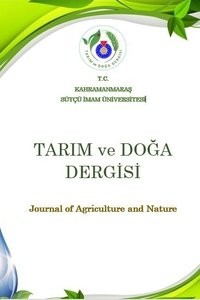Diagnosis of Nematode Populations Found in Chard, Barley and Onion Grown in North of Iraq and South of Turkey
The soil samples of three different crops namely Chards, Barely and Onion in south part of Iraq and north part of Turkey during 2014-2015 were examined and the abundance, distribution and genera of nematodes were diagnosed based on their community compositions and trophic groups. Nematodes from 230 collected soil samples from both countries extracted by Baermann systems, identified, and quantified by microscopic observations. Total number of genera belonging four trophic groups of nematodes were 19, 11, 7, and 8 for free living, plant parasite, omnivorous and predaceous nematodes, respectively. In Iraq, the highest numbers nematodes were found in free living genus of Cephalobus with 600, 1044 and 693 individual for Chard, Barley and Onion, respectively. Overall, in Turkey, the highest numbers of free living nematodes were also found in genus Cephalobus with 446, 492 and 541 individual for Chard, Barley and Onion, respectively. In study, the greater free living nematode densities in all three crops from both counties were Cephalobus followed by Chiloplacus, Rhabditis, Monhystera, Eucephalobus, Acrobeles and Wilsonema. On the other hand, the highest densities of plant parasitic nematodes were observed in Tylenchus, Pratylenchus, Aphelenchus, Filenchus, Ditylenchus, Aphelnchoides, Heterodera, Meloidogyne and Helicotylenchus. Current study indicated that the number of nematodes genus occurred in both countries differed, because of possibly different soil and environmental conditions for nematodes.
___
- Abebe E, Mekete T, Thomas WK 2011. A critique of current methods in nematode taxonomy. African Journal of Biotechnology, 10(3): 312-323.
- Bardgett RD, Cook R, Yeates GW, Denton CS 1999. The Influence of Nematodes on Belowground Processes in Grassland Ecosystems. Plant and Soil, 212(1): 23-33.
- Barker DF, Campbell AM 1981. The birA Gene of Escherichia coli Encodes a Biotin Holoenzyme Synthetase. Molecular Biology, 146(4): 451-467.
- Blaxter ML, Deley P, Garey JR, Liu LX, Scheldeman P, Vierstraete JR, Vanfleteerent JR, Mackey LY, Dorris M, Frisse LM, Vida JT, Thomas K 1998. A Molecular Evolutionary Framework for the Phylum Nematoda. Nature, 39(5): 71-75.
- Boag B, and &Williams KJ 1976. The Criconematidae of the British Isles. Ann. Applied Biological. 84(3): 361-369.
- Boag B, and Yeates GW 1998. Soil Nematode Biodiversity in Terrestrial Ecosystems. Biodivers, 7(5): 617-630.
- Boag B, Crawford JW, and Neilson R 1991. The Effect of Potential Climatic Changes on the Geographical Distribution of the Plant-Parasitic Nematodes Xiphinema and Longidorus in Europe. Nematologica, 37(1): 312-323.
- Bongers T, Bongers M 1998. Functional diversity of nematodes. Applied Soil Ecology, 10(3): 239-251.
- Bridge J, Starr JL 2007. Plant Nematodes of Agricultural Importance: A color handbook. (CRC Press; San Diego, CA, USA: 2007).
- Bulluck LR, Barker KR, Ristaino JB 2002. Influences of Organic and Synthetic Soil Fertility Amendments on Nematode Trophic Groups and Community Dynamics Under Tomatoes. Applied Soil Ecology, 21(3): 233-250.
- Hsieha J, Wangb M, Laic J, Liua H 2016. A Novel Static Cultivation Of Bacterial Cellulose Production By Intermittent Feeding Strategy. Taiwan Institute of Chemical Engineers, 63(2016): 46-5.
- Hunt DJ 1993. Aphelenchida, Longidoridae and Trichodoridae: Their Systematics and Bionomics. (Wallingford: CAB International).
- Kimenju J, Sibanda Z, Talwana H and Wanjohi W 2004. Nematology Training Manual. (Nematology Initiative for Eastern and Southern Africa).
- Neher DA 2001. Role of Nematodes in Soil Health and Their Use as Indicators. Journal of Nematology 33(4): 161-168.
- Neher DA, Wu J, Barbercheck ME, and Anas O 2005. Ecosystem Type Affects Interpretation of Soil Nematode Community Measures. Applied Soil Ecology, 30(1): 47-64.
- Rahman L, Chan KY, Heenan DP, Heenan 2007. Impact of Tillage, Stubble Management And Crop Rotation On Nematode Populations In A Long-Term Field Experiment. Soil Till. Res, 95: 110-119.
- Ruess L 2003. Nematode Soil Faunal Analysis of Decomposition Pathways in Different Ecosystems. Nematology, 52(2): 179 -181.
- Ruess L, Ferris H 2004. Decomposition Pathways and Successional Changes. Nematol. Monogr. Perspect, 2: 547-556.
- Spaull VW and Braithwaite JMC 1979. A Comparison of Methods for Extracting Nematodes from Soil and Roots of Sugarcane, Proceedings of the South African Sugar Technologists, 53:103-107.
- Steinberger Y, Sarig S 1993. Response by Soil Nematode Populations and the Soil Microbial Biomass to A Rain Episode in The Hot, Dry Negev Desert. Biology And Fertility of Soils, 16(3): 188-192.
- Wilson MJ and Kakoul-duarte T 2009. Nematodes as Environmental Indicators. (Wallingford, UK, CAB International) 315.
- Yeates GW, Bongers T, De Goede R GM, Freckman DW and Georgieva SS 1993. Feeding Habits in Soil Nematode Families and Genera an outline for Soil Ecologists. Journal of Nematology, 25(3): 315.
- Yeates GW, Ferris H, Moens T, Van der Putten WH 2009. The Role Of Nematodes In Ecosystems. (Nematodes As Environmental Indicators) 1-45.
- Young-Mathews A, Culman SW, Sánchez-Moreno S, O’Geen AT, Ferris H, Hollander A D and Jackson LE 2010. Plant-Soil Biodiversity Relationships and Nutrient Retention in Agricultural Riparian Zones of the Sacramento Valley, California. Agroforestry Systems 80(1): 41-60.
- Zhang M, Liang WJ and Zhang XK 2012. Soil Nematode Abundance and Diversity in Different Forest Types at Changbai Mountain, China. Zoological Studies, 51(5): 619-626.
- Yayın Aralığı: 6
- Başlangıç: 1997
- Yayıncı: Kahramanmaraş Sütçü İmam Üniv.
